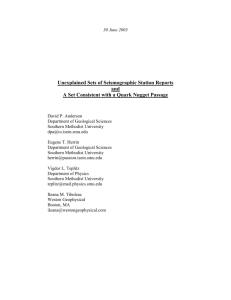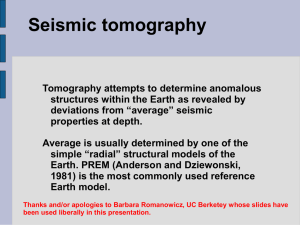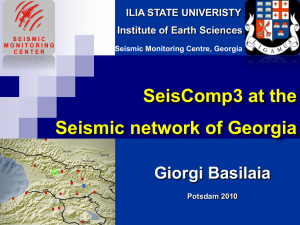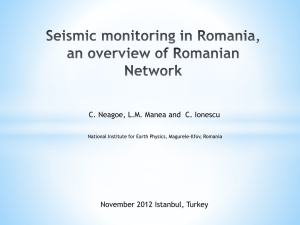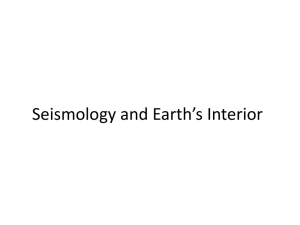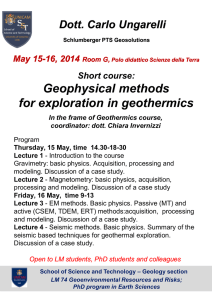Two Seismic Events With Linear Sources
advertisement
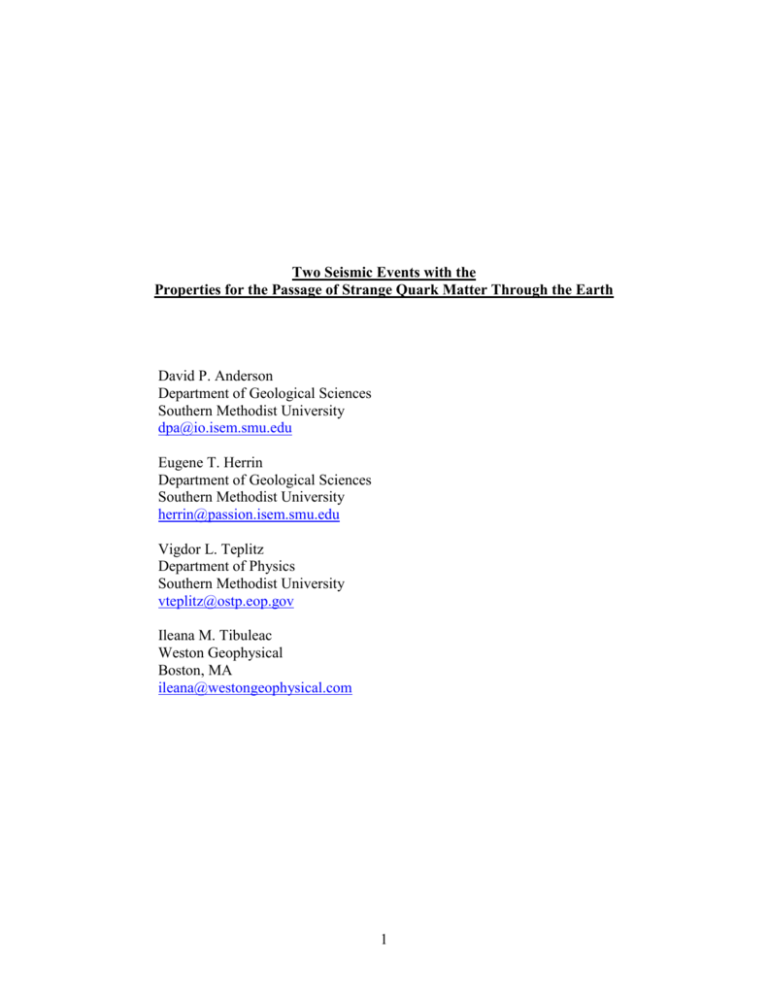
Two Seismic Events with the Properties for the Passage of Strange Quark Matter Through the Earth David P. Anderson Department of Geological Sciences Southern Methodist University dpa@io.isem.smu.edu Eugene T. Herrin Department of Geological Sciences Southern Methodist University herrin@passion.isem.smu.edu Vigdor L. Teplitz Department of Physics Southern Methodist University vteplitz@ostp.eop.gov Ileana M. Tibuleac Weston Geophysical Boston, MA ileana@westongeophysical.com 1 ABSTRACT In 1984 Witten [1] proposed that an extremely dense form of matter composed of up, down, and strange quarks may periodically strike the Earth and be detectable by the seismic signals generated from its passage. We investigated over 1 million seismic data reports sent to the U.S. Geological Survey in the years 1990-1993 that were not associated with traditional epicentral sources. It is among this set of unassociated station reports that we would expect to find events with epilinear sources should they exist. Such a source could result from the passage of a nugget of strange quark matter (SQM) through the Earth’s mantle. Two sets of reports were found that fit the epilinear source model for arrival times, array pointing, and waveform characteristics, and do not fit an epicentral source model or multiple epicentral sources model. These two events have the properties predicted for the passage of an SQM nugget. 2 I. INTRODUCTION In this paper we present very strong evidence for the detection of two 1993 seismic events with epilinear sources. We are aware of only one model that predicts seismic line events with frequency of one or two a year, namely the passage of “nuggets” of strange quark matter (SQM) through the earth. In 1984, Witten [1] pointed out that, while matter made of up and down quarks is not stable, because ups and downs condense to form protons and neutrons, matter made of up, down, and strange quarks, SQM, may well be stable. This is because of the roughly 10% decrease in kinetic energy from having three Fermi seas with which to satisfy the Pauli principle instead of just two. Witten also suggested a scenario for early universe SQM nugget production, variations of which are still under debate [2], as well as the possibility of strange quark nuggets (SQN’s) as dark matter candidates [3]. SQN’s would not be limited in total baryon number [4] as is ordinary matter. Thus very large nuggets of SQM are possible. They would have nuclear densities (~ 1014 gm/cm3). Because of the larger mass of the strange quark, an SQN with 3A quarks would have an excess of positively charged quarks over strange (negatively charged) quarks, and hence a net positive charge from “nuclear particles” which would be balanced by an electron cloud. For M>10-9 gram, the cloud would be mostly inside the nuclear part of the SQN. The SQN would be nearly neutral and, with high mass and low abundance, would not interact with electromagnetic energy, hence it’s suitability as a dark matter candidate. Finally, Witten [1] suggested looking for seismic signals from SQN’s passing through the earth, an idea considered, among others, by deRujula and Glashow [5] in more detail. This possibility motivated our work, but our detection of two epilinear source events could reflect other possible unknown phenomena. Two of us [ETH and VLT] examined detection of SQN seismic signals via a Monte Carlo calculation [6]. Briefly, a ton sized SQN would have dimensions of about 20 microns, the size of a blood cell. As it passed through the earth it would break inter and intra-molecular bonds, like a stone dropped in water, producing a seismic signal. The rate of seismic energy [E] production would be given by dE/dt = f ρV3 where is the SQN cross section, ρ is the nominal earth density, V is the SQN speed (a few hundred km/sec, the galactical viral velocity [6]), and f is the fraction of SQN energy loss that results in seismic waves rather than heat. Underground nuclear explosions have f of about 0.01, chemical ones about 0.02. The small size of SQN, which enhances coherence and depresses random motion and yields a high ratio of surface area to energy generating volume, implies that f might be larger for the SQN case. 3 Reference 6 served as a guide for the present study. It showed that almost all (98.5%) of the detections of passages of SQN’s of minimally detectable mass would be by “Class 1” seismic stations sensitive to 1 Hz waves of energy density 0.133 erg/cm2sec or better, corresponding to the capability to detect a well coupled underground explosion of 1 kT at 5000km. In the present study we search for seismic line events that might result from an SQN passage. Station observations of such an event would not be associated by current methods that assume a point source for all small seismic events. II. THE DATA Data for a linear event recognizer search were collected from the United States Geological Survey archive from 02 February 1981 through 31 December 1993. These data consist of reports turned in to the USGS from seismic stations around the world at the discretion of the individual analysts. The USGS uses these reports to determine the epicenters of earthquakes and other seismic events. Approximately 8000 separate seismic stations are included in the database. Reports which when taken collectively represent a single seismic event are referred to as “associated” reports. Reports which cannot be associated with any particular event are referred to as “unassociated” reports. Seismic signals generated by the proposed linear source will not fit the epicentral model used by the USGS to locate traditional seismic sources. Hence the “unassociated” reports are the ones of interest for this study. Most of these are likely to be unrecognized earthquake reports, multiple simultaneous or otherwise overlapping events that make association and location difficult, and potentially other, unidentified, source mechanisms. The USGS Readings (RDG) Data Set: Duration of data: Total reports: Associated: Unassociated: Avg reports/year Avg associated/year Avg unassociated/year 13 years, 02 Feb 1981 – 31 Dec 1993 9,128,892 5,889,684 3,239,208 702,222 453,052 249,169 We determined that many of the unassociated reports have arrival times that can be associated with large earthquakes as signals that have passed through the Earth’s core. These core phases have very late arrival times that make their automatic association with the source earthquake difficult, hence their prominence in the unassociated data set. The USGS Preliminary Determination of Epicenters (PDE) database was obtained for further filtering of the unassociated reports. These overlap the RDG database in the years 1990 through 1993. 4 Using the PDE data all unassociated reports from the years 1990-1993 within 60 minutes following any magnitude 4.5 or greater epicenter determination were removed. This process filtered out approximately half of the reports for each year. The data were further filtered to remove all reports except those from the 50 most sensitive “Class I” seismic stations, based on the earlier study [6]. This left about 15% of the original unassociated RDG reports. Statistics for 1993 are typical. 1993 unassociated RDG reports: Total reports: After PDE filtering: After station filtering: 284,809 152,272 38,866 For 1993 the data set contains about thirty-eight thousand reports turned in by human analysts from the 50 most sensitive seismic stations all over the world, which are not late arrivals from any recognized large earthquakes, and which were not able to be associated with any traditional (point source) seismic event. Seismic stations in the Northern Hemisphere, especially North America, are underrepresented in this set. These stations do not routinely submit reports that are not already associated with a particular seismic event. The completed filtered data set of unassociated reports from the years 1990-1993 was then searched for seismic arrival times consistent with a linear source. III. THE SEARCH A. The Point Of Closest Approach Seismic theory for signals with a linear source moving at supersonic speed through the earth implies that the first arrival at a given seismic station will come from the Point of Closest Approach (POCA) between the station and the source. This is the intersection of the trajectory with a perpendicular from the station to the line defined by the entry and exit points of the line, diagrammed in Figure 1. This POCA is offset slightly from this intersection by the angle of the MACH cone produced by the supersonic transit. In practice the effect of the cone angle is negligible at the expected velocities [6] and can be ignored. In cases where the perpendicular from the station to the line lies outside of the Earth, the POCA is the distance from the station to the closer of the entry or the exit point. 5 Figure 1. Difference between point and line events. Xs represent seismic stations and dots are the corresponding points of closest approach. An earthquake at the entry point would generate signals with the first arrival at station 1, then stations 2,3,4, and 5. A nuclearite passage would have the first arrival at station 4, near the exit, then stations 2, 1, 3, and 5. B. Travel Times Seismic signal travel times through the earth are well known (IASPE1 [7]) and calibrated down to point source depths of 700 kilometers. For this study one of us (I. Tibuleac) generated additional travel times tables by ray tracing through the standard earth model [7] to a depth of 2880 kilometers: the core-mantle boundary. Signals that travel through the core are quite complex due to reflections and refractions at the boundaries, and hence were not considered in this study. The fact that the core is roughly half an earth radius implies that roughly 75% of random strikes will not enter the core. The travel time tables generated were compared to published data [7] down to 700 kilometers and were calibrated with signals reflected from the core-mantle interface, and are in good agreement with both. 6 B. Event Windows A linear seismic source can be identified with seven or more stations reporting the arrival of unassociated signals within a T seconds window. Six parameters sufficient to uniquely define an earth-traversing linear source are: 1. entry longitude 2. entry latitude 3. exit longitude 4. exit latitude 5. source speed 6. source entry time Hence seven measurements are sufficient to constrain the source geometry with one degree of freedom for error. T was varied from 120 seconds to 1200 in 60-second intervals in accordance with the strike geometry and travel times of the POCA-to-station signals. C. The Search Algorithm The linear event recognizer (LEVR) is written in C and runs under UNIX on a SPARC10 Workstation. It searches USGS RDG data records for seismic events that fit a line rather than a point source. This search has three phases: Phase 1. Phase 2. Phase 3. STRANGE: Identify clusters of unassociated reports. LEVR: Test clusters for fit to an epilinear source. HYPOSAT: Test clusters for fit to an epicentral source. The STRANGE phase looks for groups of N≥7 unassociated stations’ reports in T≤1200 seconds. Groups of station reports that meet these criteria are passed on to the second phase. The LEVR phase is related to a standard earthquake location technique for determining epicenters by finding the best RMS fit against the observed data, but the model for calculating the travel times is an epilinear, rather than epicentral source, and is defined by an earth entry point, exit point, and source velocity. A set of time differences (t) is found by subtracting the reference station arrival time from the observed arrival times. The epilinear model determines predicted t arrival times as the POCA-to-station travel time plus the time-of-flight of the nugget through the earth, relative to the reference station. 7 LEVR does a global search of all possible strikes at 200, 400, and 600 km/sec velocity [6] for a strike that gives the minimum RMS residual, where the residual is the difference between the predicted and observed t. Simulations of synthetic linear sources demonstrate that such events produce single global minimum that can be found with a collapsing grid technique. For a given set of station reports the linear event recognizer searches the entire globe on a 10 x 10 degree grid. The minimum returned is then searched on a 1 x 1 degree grid, and then a 0.1 x 0.1 degree grid. Simulations of random sets of seismic reports can be forced to fit the linear source model for six or fewer stations. The first event found in 1993 consists of only seven stations and is therefore at the lower limit of reliability. Inclusion of the back azimuths, the direction from the station to the source, from two of the seismic arrays increases the number of parameters to nine and provides increased confidence in the fit. The two observed back azimuths point to the predicted POCAs. The second event from 1993 consists of nine station reports and two array back azimuths for a total of eleven parameters, and is an excellent fit. The travel times were further refined by calculating the effect of the elevation of the seismic stations given the distance from the source (POCA). Additional corrections for the ellipticity of the earth were not significant for the geometry of these two events. Once a good RMS linear fit was identified the search was widened to include all stations in the database in an expanded 30 minute time window. In the case of the November 1993 event this step found two additional stations, not among the fifty most sensitive, whose reports fit the linear source and refined the strike geometry, lowering the RMS residual. We also obtained waveform data from additional seismic stations in New Zealand and Antarctica that might have observed these events, but found noise levels were above the expected signal amplitudes. The third phase of the search is to run the earthquake locator program HYPOSAT [8] on the same cluster of station reports to try to fit them to a point source model, or multiple point source models. Where data were available from seismic arrays like Warramunga (WRA) and Alice Springs (ASPA), the directions to the sources (back azimuths) were obtained to further refine the fit, and the seismic waveforms were examined for the possibility of two or more simultaneous or overlapping earthquakes. Random groups of seven or more reports that might happen to fit a linear source may also be eliminated by examination of the waveforms for evidence of multiple unrelated events. One of us (I. Tibuleac) examined teleseismic events from the Australian and South American stations for reports that might show waveforms similar to the unusual signals associated with these two events, as described below, but none were found. 8 Figure 2. Surface trace for first event. IV. FIRST EVENT (10 22 1993) Two sets of reports were found in the 1993 database that fit all the criteria for a linear source. The model and residuals (observed minus predicted arrival times) for the first event are given in Table 1. The RMS residual is 0.73 sec. This RMS value would indicate a good fit for a well-located earthquake. Using the earthquake locator program HYPOSAT [8] we tried to fit a point source model to the seven arrival times and two back azimuth values, the azimuths from station to source, from the two Australian arrays (WRA and ASPA). The iterative location algorithm failed to converge after 81 iterations, showing that the data could not fit a point source model. The linear source model for this event has an entry near Elsworth Land, Antarctica, and an exit south of India (Figure 2). One problem with this event is that only seven stations reported. Times from six stations define a linear source (Entry latitude and longitude, entry time, exit latitude and longitude, and velocity are the defining parameters). In this case, however, the back azimuths determined at the two Australian arrays (ASPA and WRA) point to their respected POCA’s. Thus, there are nine observations used to estimate the parameters of the linear source model. 9 ________________________________________________________________________ Table 1 First Event (10/22/1993) Linear Source Model Entry Location and Time: Exit Location and Time: 74.60°S 6.54°N Speed: 81.5°W 86.00°E 400 km/sec 09 55 47.9 09 56 14.2 Total RMS Residual: 0.73 seconds Station and First Arrival Time POCA Depth and Distance (km) (deg) GBA (Gauribidanur, India) 09 58 52.0 0.0 ASPA (Alice Springs, Australia) 10 02 37.2 2502 WRA (Warramunga, Australia) 10 02 45.0 2376 CNCB (Chanca, Bolivia) 10 05 48.8 0.0 DST (Dursunbey, Turkey) 10 05 45.3 620 LPB (near La Paz, Bolivia) 10 05 47.0 0.0 LPAZ (La Paz, Bolivia) 0.0 Residual* (sec) 10.97 0.35 45.16 -0.40 46.67 1.17 58.27 0.39 63.66 -0.96 58.54 -0.93 58.78 10 05 47.4 0.35 *Residual defined as observed arrival time minus time predicted by linear source model. ________________________________________________________________________ 10 Fig. 3 Waveforms at the Alice Springs, Australia, array for the first event. Vertical channels only. In these figures traces show particle velocity. Displacement amplitudes at 1 Hz are a few nanometers. Waveforms at the two Australian arrays are shown in figures 3 and 4. The signals shown do not resemble what we expect to see for a small (magnitude 4) point source. The arrays recorded coherent arrivals from the west for over 30 seconds, with phase velocities indicating teleseismic P-waves. Such a waveform is consistent with a linear source west of Australia. Figure 5 shows the waveform seen at La Paz. Energy arrived with nearly constant applitude for more than 30 seconds after the first arrival, a completely unexpected form for P-waves from a small point source. All the data available to the authors are consistent with linear source model and do not fit a point source model, or two point sources. 11 Fig. 4 Waveforms at the Warramunga, Australia, array for the first event. Vertical channels only. Fig. 5 Waveform on the vertical channel at La Paz, Bolivia, for the first event. For arrivals show in Figures 3 through 5, the phase velocity is consistent with a compressional wave arrival. 12 Figure 6. Surface trace for second event. V. SECOND EVENT (11 24 1993) Evidence for a linear source for this event is even more compelling than for the first one. The model and the residuals are given in Table 2. All residuals are less than + 0.4 sec., an excellent fit of data to the model. The root-mean-square (RMS) residual is 0.15 sec. This result is better than most obtained for well-located earthquakes. Using the earthquake location program HYPOSAT [8] we tried to fit the nine arrival times and back azimuth and slowness (the reciprocal of horizontal phase velocity) values from the two Australian arrays (WRA and ASPA) with a point source model. The iterative location process did not converge until depth was fixed at 109 km, a very unlikely depth for an earthquake near the Pacific-Antarctic Ridge. After 158 iterations the program produced a final location with an RMS residual of 2.55 sec. The largest residuals were for STK, WRA and ASPA in Australia where the arrivals were clear and well timed. We consider the point source model to be highly unlikely because its RMS residual was 17 times larger than the RMS value obtained with the linear source model. 13 Table 2 Second Event (11/24/1993) Linear Source Model Entry Location and Time Exit Location and Time 46.592°S 77.879°S Speed: Total RMS Residual: 141.700°W 175.600°E 200 km/sec 0.15 seconds Station and First Arrival Time POCA Depth and Distance (km) (deg) STK (Stephens Creek, Australia) 10 26 29.3 109 CTA (Charters Tower, Australia) 10 27 26.0 270 ASPA (Alice Springs, Australia) 10 27 49.9 3 WRA (Warramunga, Australia) 10 28 08.06 55 WB2 (Warramunga, Australia) 10 28 08.06 55 MOCA (Mochava, Bolivia) 10 28 17.2 79 LPB (near La Paz, Bolivia) 10 28 33.0 0.0 CNCB (Chanca, Bolivia) 10 28 33.0 0.0 LPAZ (La Paz, Bolivia) 10 28 34.7 0.0 10 17:38.4 10:17:57.7 Residual* (sec) 48.78 -0.04 59.46 +0.12 57.68 -0.07 61.52 +0.08 61.52 +0.03 65.82 +0.03 66.95 -0.36 66.84 +0.17 67.10 +0.12 14 The surface trace of the linear source model for this event is shown in Figure 6. The points-of-closest-approach (POCA) for the Australian stations are along the last third of the linear path. The POCA’s for the Bolivian stations were at or very near the entry point. Back-azimuths computed for the two Australian arrays (ASPA and WRA) point to the POCA’s. Fig. 7. Waveforms at the Alice Springs array for the second event. Vertical channels only. Waveforms for these two arrays are shown in Figs. 7 and 8. We expect the first arrival to be essentially from the POCA followed by energy arriving from the linear source away from the POCA. The waveforms seen at the two arrays are very unusual for an event of magnitude between 4 and 4.5 as determined from the amplitude of all arrivals. There is a sharp on-set with nearly constant amplitude for several seconds after which the amplitude decreases markedly. However, the signal continues above ambient noise for over one minute. The time at which the amplitude decreases is the predicted time that the source leaves the earth. After that time only energy from the path between the entry and the POCA would be seen. This amplitude pattern is seen on all four Australian stations. 15 Fig. 8 Waveforms at the Warramunga array for the second event. Vertical channels only. These arrivals show the pattern of compressional wave energy discussed in the text. Fig. 9 Waveforms on the vertical channel at La Paz for the second event. 16 Waveforms from La Paz do not show this pattern but persist at essentially the initial amplitude for at least one minute. This pattern is consistent with a source moving away from the station with a POCA at or near the point of entry. The data for this event are consistent with the linear source model both in the arrival times, source direction as determined from the arrays, and the pattern of waveforms. The data cannot be forced to fit a point source model without unreasonably large errors. The waveforms do not show the pattern expected for a small earthquake. VI. DISCUSSION It should be noted that the number of candidate events (2) is consistent with an SQN explanation [9]. The number of SQN events, per unit time, expected is: /dt = (ρ (M)/M) S V dn Where ρ (M) is the galactic halo mass density in SQN’s of mass M, S is the earth’s crosssectional area, V is again the SQN velocity and is the detection efficiency. The Monte Carlo results of Herrin and Teplitz [6] give, for M in the 1-10 ton range, 330% likelihood of detection by 7 or more stations. Combining with our data cuts, we have roughly E ~ 0.01. The result is detection at about 1 per year if galactic dark matter (DM) is concentrated into 5-ton SQN’s. We are currently engaged in more detailed analysis, but the fact that an SQN interpretation of the seismic data implies a reasonable DM density is a useful reality check. It is, of course, possible that SQNs could be produced from collisions of the members of binary strange quark star systems that must collide after losing energy from radiation of gravitation waves [2]. In summary, we have identified, in 150,000 unassociated 1993 data reports, two sets that fit the model of a line event caused by passage of a body of nuclear density of size a few tens of microns through the earth. The fit includes signal arrival timing, array pointing, and waveform characteristics. The only explanation for such events of which we are aware is passage through the earth of ton-size strange quark nuggets. Acknowledgement: The authors wish to thank Dr. James Taggart for making the USGS database available to us and Dr. Ken Muirhead who provided digital waveform data from the Australian stations. 17 References and Notes [1] E. Witten, Phys. Rev. D30, 279 (1984) [2] See, for example, on one hand W.A. Cottingham, D. Kalafatis, and R. Vinh Mau, Phys. Rev. Lett. 73, 1328 (1984) proposing a mechanism to ensure quark nugget stability and S. Cho, K.S. Lee and V. Heinz, Phys. Rev. D50, 4771 (1984) arguing that hot quark nugget stability would violate causality. It is, however, generally agreed that “neutron stars” would be formed of or rapidly turn into strange quark stars if SQM is stable. Collisions, say of the members of a binary pair of such stars, would be a source of galactic SQN’s. [3] Suggestions of, and work on, other forms of (macroscopic) quark matter include: S. Coleman, Nucl. Phys. B 269, 263 (1985) Erratum, ibid. B 269, 744 (1985); S. Dodleson and L. Widrow, Phys. Rev. Rev. D 42, 326 (1990); K. Enqvist and J. McDonald, Phys. Lett. B 425, 309 (1998); and A. Zhitnitsky, hep-ph/0202161 (2002). Our work would not, we believe, distinguish among various forms of macroscopic quark matter. [4] E. Farhi and R.L. Jaffe, Phys. Rev. D30, 2379 (1984) [5] A. de Rujula and S.L. Glashow, Nature (London) 312, 734 (1984) [6] E.T. Herrin and V.L. Teplitz, Phys. Rev. D33, 6762 (1996) [7] IASPE1 Seismological Tables, ed. B.L.N. Kennett, Research School of Earth Sciences, Australian National University, 167 p. (1991) [8] HYPOSAT, J. Scheitzer, NORSAR Semi-technical Summ., 1 Apr. – 30 Sept., Kjeller, Norway, 1997. [9] Note that one similar explanation for linear seismic sources could conceivably be a black hole transit. However, a 10-micron black hole would have a mass on the order of 1023gm, and hence would have to be too rare for likely detection in order not to exceed the limit on galactic DM. 18


